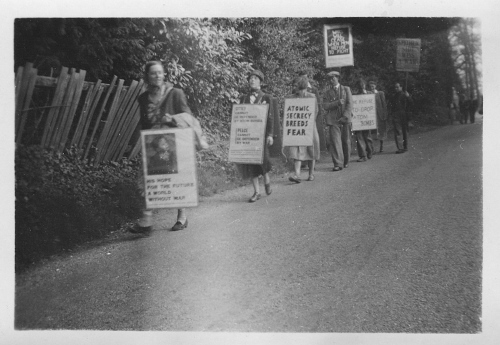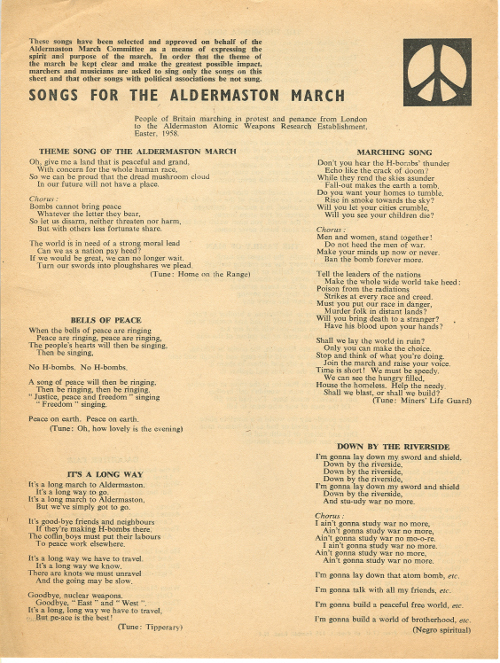Archives Hub feature for March 2017
Browse descriptions relating to nuclear disarmament on the Archives Hub.
The nuclear disarmament symbol, often known as the ‘peace sign’, is a modern icon, used by protestors and activists across the world and provoking powerful emotions. It is ubiquitous in fashion and youth culture, to be seen on clothing, jewellery, tattoos, even toiletries. Special Collections at the University of Bradford is home to the original sketches of this extraordinary design.

The symbol was designed in 1958 by Gerald Holtom, an artist based in Twickenham. It was intended for use on a march from London to the nuclear weapons research establishment at Aldermaston that Easter. The march was being organised by a small group of activists influenced by Gandhi’s ideas about nonviolent resistance; they had formed the Direct Action Committee against Nuclear War (DAC) the previous year in response to the testing of Britain’s first hydrogen bomb.

In creating the visuals for the march, Holtom wanted to develop a symbol for the concept of nuclear disarmament. In a 1973 letter to Hugh Brock (editor of Peace News in 1958, active in the Direct Action Committee), Holtom remembered:
“I was in despair. Deep despair. I drew myself: the representative of an individual in despair, with hands palm outstretched outwards and downwards in the manner of Goya’s peasant before the firing squad. I formalised the drawing into a line and put a circle round it. It was ridiculous at first and such a puny thing …“.
The symbol also represented the semaphore signals for the letters N and D: Nuclear Disarmament.
Holtom sketched his design to meet the need of the moment; he did not expect the sketches to be of interest or preserved years into the future, and nor did many of his contemporaries. Among our other loans to the IWM, we see a letter from a fellow activist dated 10 March 1958; she rejected the use of the symbol, calling it ‘quite obscure’ and suggestive of ‘some Secret Society’.

However, the march organisers were pleased with the design and it was used extensively on DAC literature thereafter. Reflecting huge public anxiety about nuclear testing and the arms race, the 1958 Easter march attracted much larger numbers and attention than previous protests directed at Aldermaston. Marchers, passers-by, readers of newspapers; all saw the symbol in action, on leaflets, flyers, song-sheets and banners. Its popularity was assured when later that year the Campaign for Nuclear Disarmament asked to adopt the symbol, and it has been synonymous with nuclear disarmament campaigns ever since. Easy to draw and to adapt, and hinting at other shapes and symbols (a missile, a tree …), the symbol was widely adopted by 1960s counter-cultural groups and came to symbolise peace and dissent more generally.

The original sketches remained with the papers of Hugh Brock. Following his death in 1985, these materials were given to the Commonweal Library, an independent public library, which stocks resources to help activists working for nonviolent social change. Commonweal is housed in the J.B. Priestley Library at the University of Bradford so, when the University set up its Special Collections service during the 2000s, it was natural for Commonweal to put their archival collections into the care of these specialist staff.
The sketches are among the most important objects held by Special Collections. There are four sketches, on three pieces of paper: two drawings of the shape and two illustrations of it in use on protest marches. Reproduction does not do these objects justice. In the flesh we see the weakness of the acidic paper, the cracking of the paint, and the wear and tear of storage and display.
2017 offered a rare chance to see these fragile originals on show. ‘People Power: fighting for peace’ was on show at the IWM London from 23 March-28 August 2017. The sketches took their place among hundreds of objects illustrating the stories of anti-war campaigners in Britain from 1917 to the present. Many of these stories can also be found through the Archives Hub.
Alison Cullingford
Special Collections Librarian
University of Bradford
Explore
Peace campaign archives in Special Collections at the University of Bradford, including:
- Archives of the Direct Action Committee Against Nuclear War (1957-1961)
- The papers of Hugh Brock (1914-1985)
- Papers of Michael Randle (b.1933)
Campaign for Nuclear Disarmament archives, at the Modern Records Centre, University of Warwick:
Related features
Two-part feature from September 2006 on nuclear power and nuclear weapons:
Images copyright: Cwl ND symbol drawings courtesy of the Trustees of the Commonweal Collection. March songs Cwl DAC, march photograph Cwl HBP. Rights unknown. Article copyright: University of Bradford, shared under Creative Commons licence (CC BY-NC-SA). [Note that portions of this text have been adapted from existing blog posts and exhibition captions created by Special Collections.]
